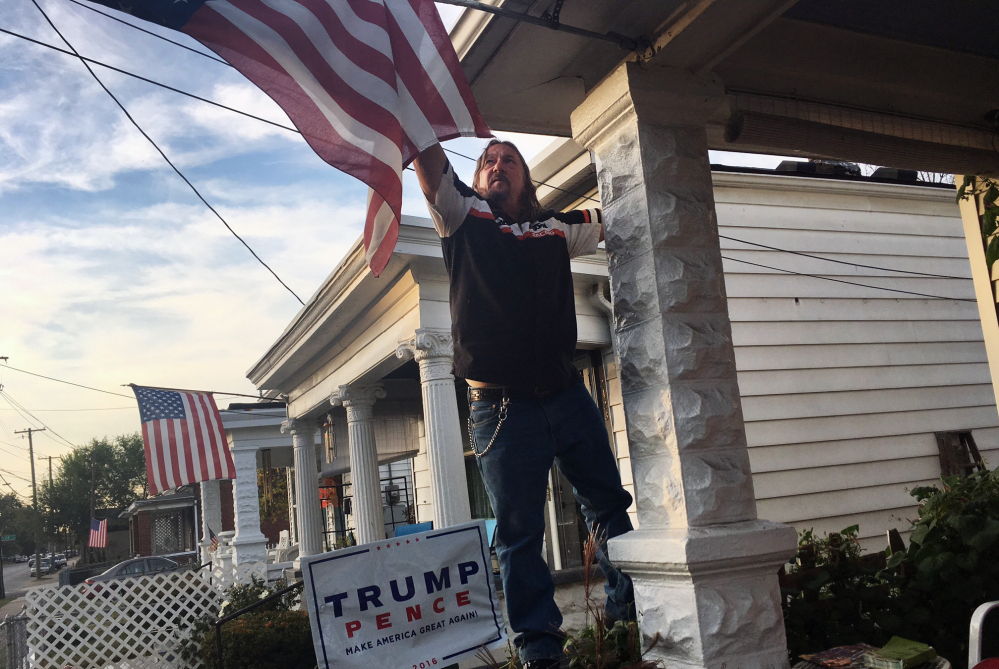WASHINGTON — White working-class voters are fleeing the Democratic Party and it’s unlikely they’re coming back anytime soon.
Donald Trump won 43 percent of the votes in union households, even though the AFL-CIO backed Hillary Clinton. He won 2 to 1 among white men and by 10 points among white women. He won 2 of 3 votes from whites without college degrees.
These voters often felt ignored and disrespected by Clinton and her party, who should have seen it coming.
“Democrats embarked on a course a generation ago that was organized around the inclusion of the excluded. That was a fateful decision,” said Will Marshall, the president of the Progressive Policy Institute, a centrist Democratic-leaning research group.
While that was “morally the right decision” he said, “it’s had fateful consequences.”
White working-class voters often feel left out as the government provides advantages to others seeking jobs or getting their children into college and to those who entered the country illegally.
The white working class sees the system tilted against them, and they often blame the Democrats for making it that way.
“White working-class people have been caught in a bind,” explained Donald Fowler, former Democratic chairman. Trade and technology have helped eliminate jobs they filled, and they don’t always have the education or skills to fill newer positions.
“Republicans have done a much better job of blaming Democrats for this,” Fowler said.
Trump positioned himself against what AFL-CIO President Richard Trumka called “the political elites,” saying they too often “embraced economic policies that hold down wages, increase inequality, diminish opportunity and ship American jobs overseas.”
He voiced a complaint among middle- and lower-income workers that’s been reverberating throughout the campaign: While the economy keeps growing, they think it’s not growing fast enough, that Washington’s not sensitive to their insecurity.
“They just don’t feel government is working for them,” said Gary Pearce, a Democratic consultant based in Raleigh, N.C.
Trump supporters agreed.
John Sarcone, a New York attorney and Trump supporter, said his younger brother told him 400 members of his Teamsters Union had registered to vote for the first time.
“He texted me and said the owner of the company shut the company down at 3 p.m. so that everyone could go and vote for Trump. That’s the silent majority,” Sarcone said.
While Democrats and experts agree on the diagnosis, few are optimistic a cure is nigh.
“The party is already pro-union, pro-minimum wage and for the middle class. So what does it do? Jettison Latinos? Become a pro-life party?” asked Susan Demas, editor and publisher of Inside Michigan Politics, a nonpartisan newsletter that follows state politics.
The Democrats’ predicament is most obvious in Michigan and Wisconsin, which until Tuesday were reliably Democratic presidential states. Wisconsin last voted Republican in a presidential election in 1984. Michigan last went for a Republican nominee in 1988.
Trump won both.
About 28 percent of Michigan households are union households, and Clinton won only 53 percent. She got the same percentage among union households in Wisconsin, where they account for 1 of every 5 votes.
The working-class exodus is hardly new. In the 1980s, Ronald Reagan won so many of these households they came to be known as Reagan Democrats. Bill Clinton in 1992 was able to win back many, mainly because of his ability to govern Arkansas largely from the center.
Once in the White House, Clinton questioned liberal orthodoxy, championing an overhaul of the nation’s welfare system and raising questions about affirmative action. “He knew how to speak to voters, to convince them he was rewarding hard work,” Marshall said.
Bill Clinton’s legacy didn’t endure. Republicans effectively charged President Obama with governing from the left, notably with his signature health care overhaul. By 2010, Wisconsin and Michigan elected Republican governors. Republicans took control of the House of Representatives. Obama, though, retained support among union households, winning them 2 to 1 in both states.
Trump’s tough talk on trade was particularly effective. Half of Michigan’s voters said trade policy had cost jobs, and they voted overwhelmingly for him.
Today, people look at the party and too often “they feel there’s nobody speaking or fighting for them,” said Jaime Harrison, South Carolina Democratic chairman.
Send questions/comments to the editors.



Success. Please wait for the page to reload. If the page does not reload within 5 seconds, please refresh the page.
Enter your email and password to access comments.
Hi, to comment on stories you must . This profile is in addition to your subscription and website login.
Already have a commenting profile? .
Invalid username/password.
Please check your email to confirm and complete your registration.
Only subscribers are eligible to post comments. Please subscribe or login first for digital access. Here’s why.
Use the form below to reset your password. When you've submitted your account email, we will send an email with a reset code.